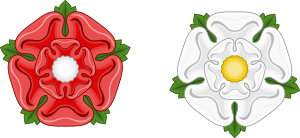Battle of Ferrybridge facts for kids
The Battle of Ferrybridge was a small but important fight that happened on March 28, 1461. It was a warm-up battle before a much bigger one called the Battle of Towton. These battles were part of a long conflict in England known as the Wars of the Roses. This war was fought between two powerful families, the House of York (who used a white rose as their symbol) and the House of Lancaster (who used a red rose).
Quick facts for kids Battle of Ferrybridge |
|||||||
|---|---|---|---|---|---|---|---|
| Part of Wars of the Roses | |||||||
 |
|||||||
|
|||||||
| Belligerents | |||||||
| Commanders and leaders | |||||||
| Strength | |||||||
| unknown | unknown | ||||||
| Casualties and losses | |||||||
| 3,000 | |||||||
Setting the Scene: The Yorkist March North
After declaring himself king, Edward IV gathered a large army. He then marched his forces north. Their goal was to confront the Lancastrian army. The Lancastrians were positioned behind the Aire River in Yorkshire.
On March 27, the day before the battle, the Earl of Warwick led the first part of the Yorkist army. They needed to cross the river at Ferrybridge. The Lancastrians had already destroyed the bridge there. Warwick's men had to build a new one using planks. This was a very difficult task. Many soldiers were lost to the freezing cold water. They also faced constant arrows from a small but determined Lancastrian group on the other side. Once they finally crossed, Warwick's men repaired the bridge. They then set up their camp on the north side of the river.
The Battle Begins: A Surprise Attack
Early the next morning, the Yorkist soldiers were completely surprised. A large group of Lancastrians attacked them. This Lancastrian force was led by Lord Clifford and Lord Neville.
Warwick's forces were caught off guard and became confused. They suffered many losses. Lord FitzWalter, who was Warwick's second-in-command, was badly wounded. He died about a week later. Warwick's half-brother, known as the Bastard of Salisbury, was also killed. Even the Earl of Warwick himself was injured. An arrow hit him in the leg as he tried to retreat. One historian, Jean de Wavrin, wrote that almost 3,000 men died in this fighting.
After the Fight: Yorkists Strike Back
After the surprise attack, King Edward arrived with the main Yorkist army. Warwick and Edward went back to the bridge. They found it was ruined again.
Warwick then sent his uncle, Lord Fauconberg, with the Yorkist cavalry. They rode upstream and crossed the river at a place called Castleford. Lord Fauconberg chased after Lord Clifford. He caught up with Clifford near the main Lancastrian army. After a fierce struggle, Fauconberg defeated Clifford's group. Lord Clifford was killed by an arrow to his throat. It is said he had removed the piece of armor that should have protected that area.

